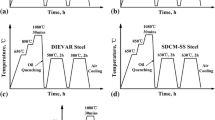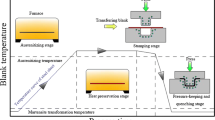Abstract
Cooling rate at core site (Rc, °C/s) of hot stamping die components affects the life cycle in use. To achieve accurate prediction of Rcs of Cr-Mo-V-W steels in dependence of tungsten content (w%), working temperature Ti and surface temperature Ts, we carried out real-time detection of the temperature of Cr-Mo-V-W steel cylinders cooling in quenching sand. Cr-Mo-V-W die steel with 1.5% of tungsten had the highest heat conductivity in working temperature range from 200°C to 600°C, and it was ascribed to tungsten reducing the interstitial atoms in matrix and improving the heat conductivity. A cooling temperature trend (CTT) model was constructed. Compared with the modified Fourier model, the CTT model can predict the Rc of Cr-Mo-V-W steels more precisely.









Similar content being viewed by others
References
M. Zhang, S. Xing, Q. Xin, L. Xiao, and J. Gou, J. Iron Steel Res. Int. 15, 47 (2008).
A. Alimi, J. Fajoui, M. Kchaou, S. Branchu, R. Elleuch, and F. Jacquemin, Eng. Fail. Anal. 62, 142 (2016).
R. Wu, J. Li, Y. Su, S. Liu, and Z. Yu, Mater. Sci. Eng. A 706, 15 (2017).
S.A. Nikulin, A.B. Rozhnov, S.O. Rogachev, T.A. Nechaykina, V.I. Anikeenko, and V. Yu, Mater. Lett. 485, 499 (2016).
P. Carlone and G.S. Palazzo, Int. Appl. Mech. 46, 955 (2011).
A. Kulawik and A. Bokota, Arch. Metall. Mater. 56, 1431 (2011).
Q.C. Jiang, X.M. Zhao, F. Qiu, T.N. Ma, and Q.L. Zhao, Acta Metall. Sin. (Engl. Lett.) 31, 692 (2018).
Z. Jian, D.S. Ma, H.X. Chi, Z.Z. Chen, and X.Y. Li, J. Iron Steel Res. Int. 9, 120 (2013).
R.M. Wu, W. Li, M. Chen, S. Huang, and T. Hu, Mater. Sci. Eng. A 812, 141140 (2021).
R. Kannan, V.S. Srinivasan, M. Valsan, and K.B.S. Rao, Trans. Indian Inst. Met. 63, 571 (2010).
Y. Meng and B.G. Thomas, Metall. Mater. Trans. B 34, 685 (2003).
P. Frank, P. David, L. Theodore, S. Adrienne, and F.P. Incropera, Fundamentals of Heat and Mass Transfer, 6th edn. (Wiley, 2007), p168.
G. Lorenzini and L.A.O. Rocha, Int. J. Heat Mass Transf. 52, 1458 (2009).
J.A. Cardle, Int. J. Numer. Methods Eng. 38, 171 (2010).
M.J. Peet, H.S. Hasan, and H.K.D.H. Bhadeshia, Int. J. Heat Mass Transf. 54, 2602 (2011).
F.H. Herbstein and J. Smuts, Philos. Mag. 8, 367 (1963).
A. Matthiessen, C. Vogt, and D. Ann, Phys. U. Chem. 122, 19 (1864).
Acknowledgement
This research has been supported by the Class III Peak Discipline of Shanghai—Materials Science and Engineering (High-Energy Beam Intelligent Processing and Green Manufacturing).
Author information
Authors and Affiliations
Corresponding author
Ethics declarations
Conflict of interest
The authors declare that they have no known competing financial interests or personal relationships that could have appeared to influence the work reported in this paper.
Additional information
Publisher's Note
Springer Nature remains neutral with regard to jurisdictional claims in published maps and institutional affiliations.
Rights and permissions
Springer Nature or its licensor (e.g. a society or other partner) holds exclusive rights to this article under a publishing agreement with the author(s) or other rightsholder(s); author self-archiving of the accepted manuscript version of this article is solely governed by the terms of such publishing agreement and applicable law.
About this article
Cite this article
Zhang, Y., Wu, R., Min, N. et al. Cooling Rate of Hot Stamping Dies by Constructed Cooling Temperature Trend Model. JOM 75, 5198–5207 (2023). https://doi.org/10.1007/s11837-023-05955-8
Received:
Accepted:
Published:
Issue Date:
DOI: https://doi.org/10.1007/s11837-023-05955-8




